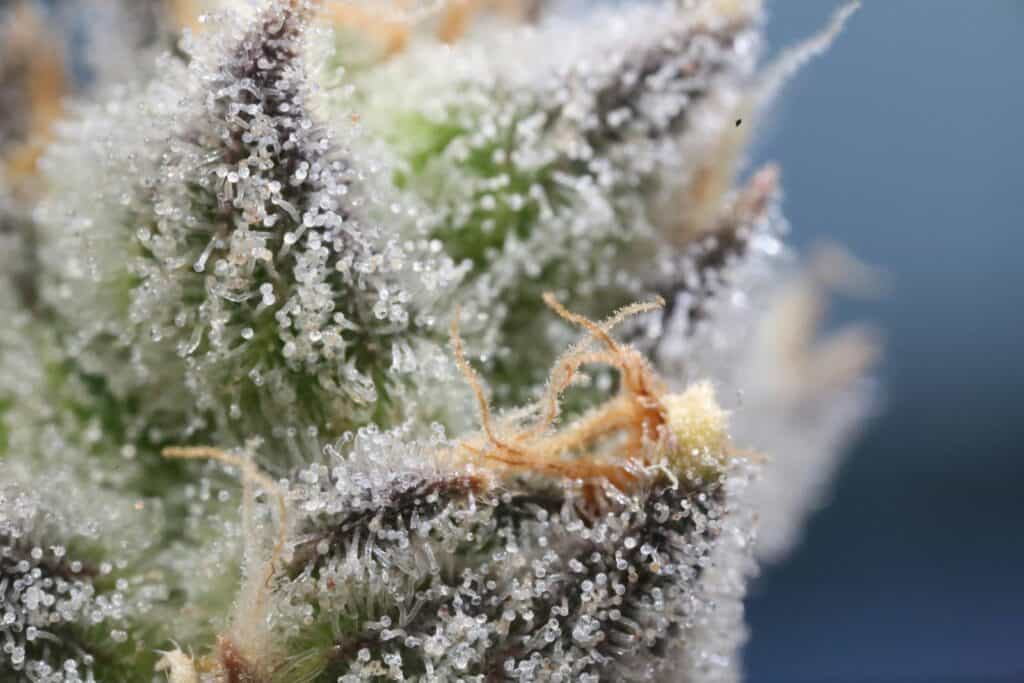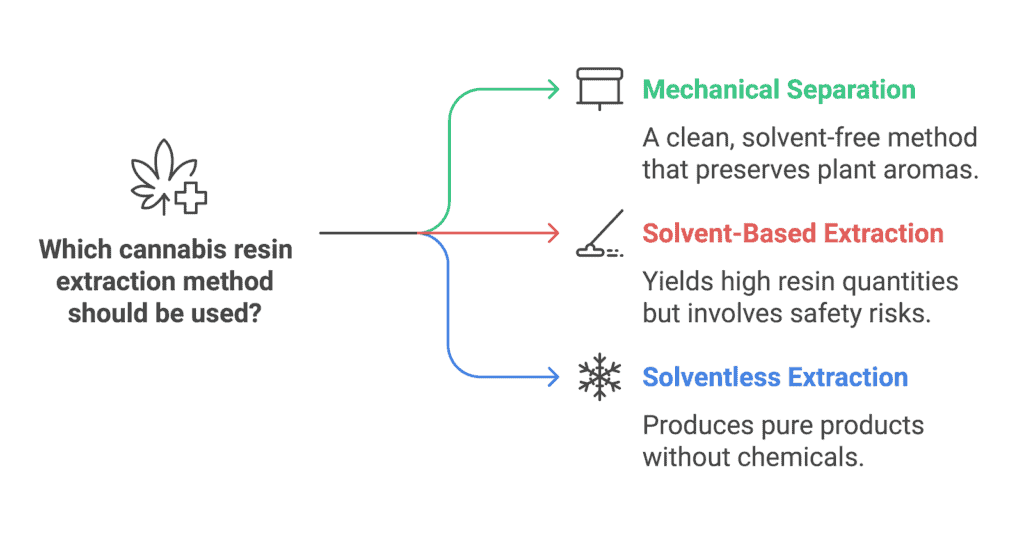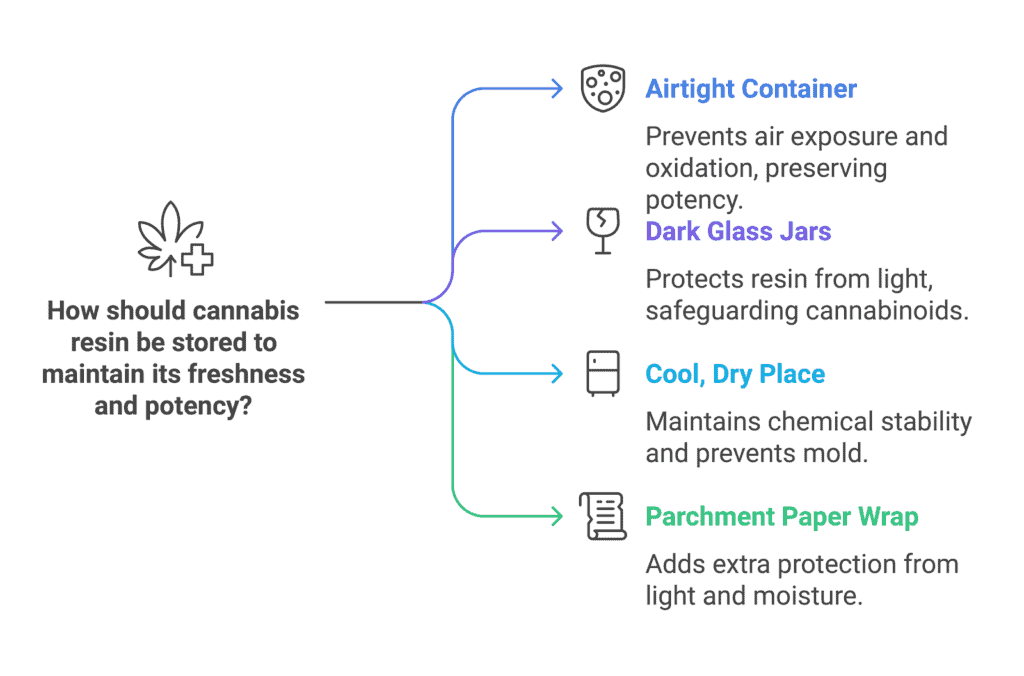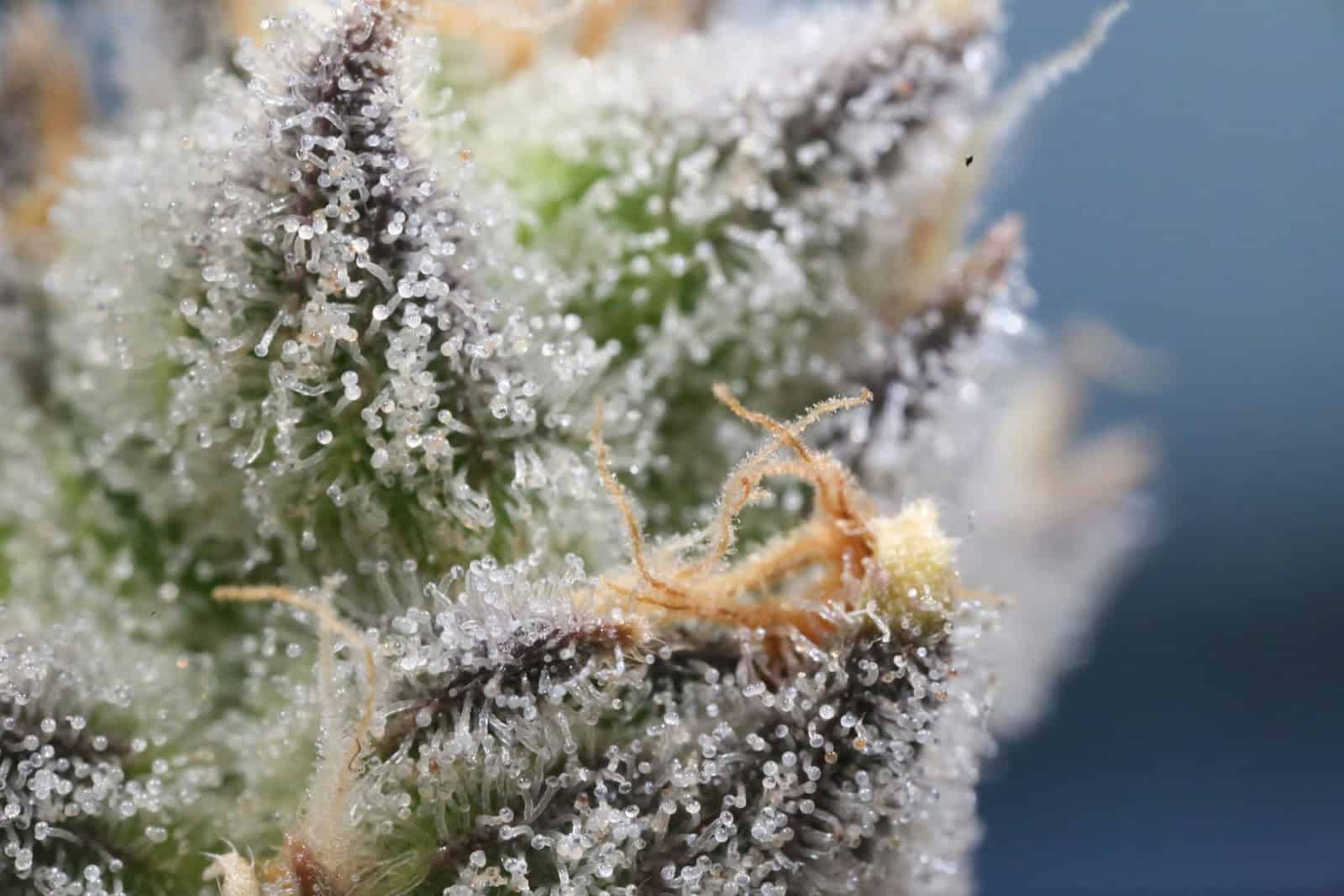
The cannabis plant produces resin, a sticky material that contains terpenes and trichomes, as well as protects it from parasites and UV radiation. Resin also contains THC which gives cannabis its flavor and potency. Understanding cannabis resin can improve your appreciation of the plant and its uses.
Resin is important in the cannabis industry because it can be used in oils and concentrates. Knowing how to safely store and handle resin is also important for those looking to enjoy its benefits.
This article will discuss the many varieties of cannabis resin and the ways they are extracted.
Key Takeaways
Key compounds are found in cannabis resin, which is important for protecting the cannabis plant.
Resin extraction processes produce different resins for different purposes.
The sticky substance is most effective and safest when it is kept and used carefully.
What Are Cannabis Resins?
Cannabis resin is a concentrated plant product. It contains a mix of important compounds that contribute to its unique characteristics and effects.
Cannabis resin contains a lot of terpenes and cannabinoids. It also contains cannabinoids such as THC (tetrahydrocannabinol) which is known for its psychoactive effects. These chemicals affect mood and perception via the endocannabinoid system.
Besides THC, resin possesses other cannabinoids like CBD which have several advantages. Terpenes are also present, giving resin its distinct smell and taste. This chemical mix characterizes some cannabis strains’ effects and enriches their experience.
Physical Characteristics
You can describe cannabis sativa resin as a sticky material that varies in color. It can vary from light brown to dark brown, and because of its composition, it often looks shiny or crystalline. Cannabis flowers and leaves have tiny hair-like structures called trichomes which is where resin forms.
After gathering, this resin might be difficult to separate from plant debris. It can be gooey or waxy depending on handling. Cannabis resin is concentrated and high in cannabinoids, so even small amounts can have a big effect.
Types of Cannabis Resin

Each type of cannabis resin has its own properties and extraction methods. Knowing these varieties helps you choose the right product.
Hash Oil
Hash oil, also known as butane hash oil (BHO), is a popular cannabis concentrate. Butane is used to extract cannabis’ potent oils. People commonly dab with this oil since it is so powerful.
Veteran cannabis users like hash oil’s taste and strength. Keep in mind that the production process might vary, resulting in varying textures and consistencies. Popular variations include shatter, wax, and crumble. Each offers a unique experience.
Solid Concentrates
Hashish and dry sift are solid concentrates. Hashish is made by compressing the resin from the cannabis plant, primarily from trichomes. This process results in a firm, sticky substance.
Dry sift is made from filtered cannabis plant trichomes. This produces kief, a fine, powdered concentration. Both varieties are easy to use and may be smoked, vaped, or added to joints for a greater impact.
Rosin and Live Resin
Heat and pressure create a solventless concentrate called rosin from cannabis plant buds or hash. This method preserves terpenes, giving the product flavor. Rosin is also quite versatile.
Live resin comes from uncured cannabis picked recently and flash-frozen before extraction. This keeps a greater variety of terpenes and cannabinoids, giving it a powerful flavor and scent. Cannabis users prefer both products for their quality and potency.
Methods of Extraction

Cannabis resin may be extracted using several ways. Each approach contains procedures and processes that affect product quality and attributes. Three common extraction methods are:
Mechanical Separation
One of the earliest cannabis resin extraction processes is mechanical separation. To separate the trichomes, which are tiny glands that carry resin, this approach employs physical motions like pressing or shaking cannabis flowers.
You may conduct this approach by utilizing screens or mesh bags to clean away the sticky substance from the plant material. The concentrated trichome-rich powder is called kief.
This solvent-free resin collection method is clean and straightforward. It’s safe and protects the plant’s smells and scents because it uses physical agitation.
Solvent-Based Extraction
Multiple solvents are used to extract resin from plant material. Common solvents include butane, ethanol, and propane. This method tends to yield a higher quantity of resin than mechanical methods.
The solvent breaks down desired cannabis components during extraction. These substances include cannabinoids and terpenes. Once extraction is complete, the solvent is evaporated, leaving behind a concentrated oil.
This process may create a broad range of products, including oils like BHO (butane hash oil). However, solvents can be dangerous if misused or not properly removed from the end product.
Solventless Extraction Methods
Solventless extraction techniques get cannabis resin without chemicals. One of the most popular methods is ice water hash extraction, also known as bubble hash.
In this technique, ice and water are used to freeze and agitate the plant material. In cold weather, trichomes break off, making them easier to gather. To achieve a clean ice water hash product, the separated resin is subsequently passed through mesh bags.
Pressing releases cannabinoids and terpenes from cannabis material using heat and pressure. This allows for the creation of goods like rosin, which is preferred for its purity.
Uses of Cannabis Resin
Cannabis resin serves different applications, especially in recreational and therapeutic situations. Understanding these uses can help you appreciate its benefits.
Recreational Use
Cannabis resin is utilized by a lot of individuals for enjoyment. It is often found in hash or concentrates, which give you a strong high.
You may smoke or vaporize resin using a number of smoking equipment. Some users prefer dipping, which delivers a greater impact owing to the high THC concentration. The psychoactive properties induce relaxation and euphoria.
Cannabis resin potency varies greatly. This means you should start with a small amount, especially if you are new to using it.
Medical Uses
- The resin from cannabis is also medicinal. It might help with pain from arthritis, migraines, or chronic pain. Many patients turn to resin when traditional medications do not alleviate their symptoms effectively.
- The resin’s cannabinoids affect the endocannabinoid system. This interaction can help decrease inflammation and induce calm.
- Other potential benefits include reducing anxiety and improving sleep quality. Patients often smoke or eat it.
To achieve results, you must know the effects and doses. Consult a doctor before using cannabis resin medicinally.
Storing and Handling Resin
Cannabis resin must be stored and handled properly to stay effective. By following certain steps, you can preserve its flavor and potency while ensuring safety.
Proper Storage

To keep cannabis resin fresh, put it in an airtight container. Air exposure can oxidize and reduce potency, therefore this prevents it. Dark glass jars are good for resin storage. Light can harm cannabinoids, while dark glass protects resin.
Remember to store resin in a cool, dry place. Heat can change the chemical makeup, while moisture can encourage mold and degradation. A refrigerator is ideal for long-term storage. If you prefer shorter storage periods, a cold, dark area also works.
For added protection, consider wrapping your resin in parchment paper before placing it in the container. This offers light and moisture protection.
Handling Resin for Use
When handling cannabis resin, remember to keep your hands clean and dry. Finger oil or moisture can degrade quality. Utilize dabbers for consumption. This reduces direct touch and preserves resin.
Before using the resin, make sure to let it reach room temperature. Cold resin is difficult to deal with. Allowing it to warm up slightly makes it easier to handle.
Also, do not expose your resin to heat sources before using it. Doing so can quickly degrade it. Knowing how to store and handle cannabis resin improves its longevity and overall enjoyment.
Cannabis Resin in the Industry
Resin is important to the cannabis industry. Its form is ideal for different uses and offers distinct recreational and therapeutic benefits. Understanding cannabis resin commercial products and legal issues can help you navigate this changing landscape.
Commercial Goods
Cannabis resin is sold in many products.
- Potent butane hash oil (BHO) is popular. Many users like dabbing.
- Another commercial product, live resin, tastes like fresh cannabis and contains several terpenes.
- Cannabis wax is a resin product that has a high THC content and consistency.
Specialized methods and tools are used to make these items. Manufacturing requires quality control for safety and potency. Proper testing helps you understand what you’re consuming.
Various dispensaries provide these concentrates, allowing you to customize your effects.
Legal Considerations
The legal status of cannabis resin varies significantly. Some places allow medical and recreational usage. Others ban or restrict it. Know your local cannabis and product regulations.
Cannabis users must know the rules to use safely. Additionally, the market for cannabis resin can be influenced by legislation on hemp and other cannabis-related materials.
Some locations require permits to make and sell cannabis extracts. Understanding these legal factors keeps you compliant and aware of regional developments.
Regulations and Safety
Safety and legal requirements must be considered while utilizing cannabis resin. Understanding these factors can help you choose and use cannabis responsibly.
Warnings Concerning Safety
Before consuming cannabis resin, evaluate the potency. THC and other cannabinoids are abundant in cannabis resin. A little goes a long way, so start with little quantities to test your tolerance. Use it in a pipe or bong with caution due to its concentration.
Always store your cannabis resin in a cool, dark place. This helps keep its efficacy and avoids deterioration from heat and light. Keep it out of reach of children and pets to prevent accidental ingestion. Research extracts and concentrates’ safety and processing requirements before using them.
Regulatory Standards
Regulations on cannabis resin differ by area. Some areas have legalized its medical and recreational use, while others maintain strict prohibitions. Always check local laws. Legal products may need safety and quality criteria. We test for contaminants and label THC accurately.
In locations where cannabis is legal, producers must follow criteria that assure safe manufacturing and delivery. Regulations may cover packaging, child-proof containers, and labeling. Safe and high-quality cannabis extracts, concentrates, and oils need compliance with these requirements.
Bottom Line
Cannabis resin is a versatile and potent product that plays a vital role in the cannabis industry, offering both recreational and medicinal benefits. With its high concentration of cannabinoids and terpenes, resin provides users with enhanced effects and unique flavor profiles. From hash oil to live resin, the various types cater to different preferences and uses, making it a sought-after product for cannabis enthusiasts.
Understanding its extraction methods, safe handling, and proper storage is essential to preserving its quality and enjoying its full potential. Whether used for therapeutic relief or recreational enjoyment, cannabis resin stands out as a concentrated, impactful option in the world of cannabis products. By staying informed about its benefits, applications, and legal considerations, you can make the most of what cannabis resin has to offer.
Frequently Asked Questions
How is cannabis resin utilized?
Cannabis resin has many uses. Common methods include dabbing, where the resin is heated and inhaled, or incorporating it into edibles. Vaping is another popular choice for those looking for a healthier option.
What separates cannabis resin from hash?
Cannabis resin is a sticky substance with cannabinoids and terpenes. However, hash resin is pressed and processed. This implies that despite both coming from the same plant, their manufacturing techniques and textures differ.
Legal issues with cannabis resin?
Local cannabis laws vary. Resin may be legal where cannabis is. However, in some locations, cannabis resin might be banned owing to its high THC level. Always verify local restrictions before buying or using it.
Can you explain the look of cannabis resin?
Resin from cannabis normally looks like a sticky, amber-colored material. Because it contains a lot of trichomes, the surface may be lustrous. Depending on extraction and storage, it might be mushy or solid.
What benefits does cannabis resin have?
There are many benefits to using cannabis resin, including a stronger high because it has more THC in it. Users enjoy its enhanced flavors and aromas for recreational and medicinal use.
Does cannabis resin have more potency than buds?
Indeed, cannabis resin is typically stronger than buds. This is because it contains a much higher concentration of THC and other cannabinoids. Therefore, careful dosage is necessary because even a small amount can have strong effects.








